

STS Program » About » What is STS? Science and Technology Studies (STS) is a relatively new academic field.

Its roots lie in the interwar period and continue into the start of the Cold War, when historians and sociologists of science, and scientists themselves, became interested in the relationship between scientific knowledge, technological systems, and society. The best known product of this interest was Thomas Kuhn’s classic 1962 study, The Structure of Scientific Revolutions. This influential work helped crystallize a new approach to historical and social studies of science, in which scientific facts were seen as products of scientists’ socially conditioned investigations rather than as objective representations of nature. Among the many ramifications of Kuhn’s work was a systematic effort by social scientists to probe how scientific discovery and its technological applications link up with other social developments, in law, politics, public policy, ethics, and culture. Additional Readings Useful Links.
RELATIONSHIP BETWEEN SCIENCE, TECHNOLOGY AND SOCIETY. Sagarkumar Chavda Department of Physics, Saurashtra University, Rajkot, 360005, Indiasagar.skc@gmail.com Abstract This paper attempts a historic-scientific interpretation of relationshipbetween science, technology, and society.
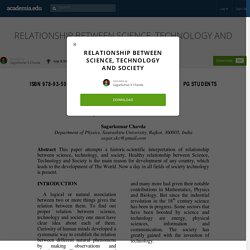
Healthy relationship between Science,Technology and Society is the main reason for development of any country, whichleads to the development of The World. Now a day in all fields of society technologyis present. Teaching Material: Curriculum & Lesson Plans. Can You Recognize Democracy When You See It?
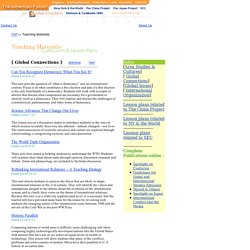
Grade Level:9-12 This unit puts the question of “what is democracy” into an international context. Focus is on what constitutes a free election and asks if a free election is the only benchmark of a democracy. Students will work with excerpts of articles that discuss what components are necessary for a government to identify itself as a democracy. They will explore and discuss the challenges of constitutional, parliamentary and other forms of democracy. Science Advances That Change Our Lives Grade Level:7-12 This lesson acts as a discussion starter to introduce students to the ways in which science/scientific discovery has affected—indeed, changed—our lives. The World Trade Organization Grade Level:9-12 Three activities aimed at helping students to understand the WTO. Rethinking International Relations -- A Teaching Strategy Grade Level:10-12 Historic Parallels Grade Level:9-12. Global Connections in the CCPS Curriculum.PDF. World Trade—A Global Interdependence.PDF.
Inter vs. Intra. Rights duties resp. CITWorksheet.pdf. Can I? Rights vs Responsibilities.pdf. Citizen_me_1.pdf. 2ndGradeSSUnit3.PPT. U.S. Federal Government - Basic Structure & Functions. Core values of american constitutional democracy. The Core Democratic Values. The Core Democratic Values Simply put the Core Democratic Values are ideals that are important to us as Americans.
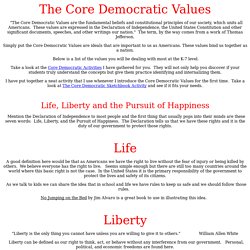
These values Take a look at the Core Democratic Activities I have gathered for you. They will not only help you discover if your students truly understand the concepts but give them practice identifying and internalizing them. I have put together a neat activity that I use whenever I introduce the Core Democratic Values for the first time. Life, Liberty and the Pursuit of Happiness Life A good definition here would be that as Americans we have the right to live without the fear of injury or being killed by others. No Jumping on the Bed by Jim Alvaro is a great book to use in illustrating this idea. Liberty "Liberty is the only thing you cannot have unless you are willing to give it to others. " Pursuit of Happiness "Go West young man and grow up with the country. " Having fun at home or school, but following the rules is another way of sharing this idea. The Common Justice. Democracy (Power to people) Vs. Republic (Power in Government) American Indian Sovereignty Curriculum.
Chapter_9-tribalgovernment.pdf. Indian Affairs - State of Minnesota. In Minnesota, there are seven Anishinaabe (Chippewa, Ojibwe) reservations and four Dakota (Sioux) communities.
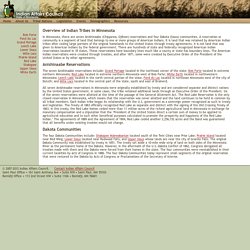
A reservation or community is a segment of land that belongs to one or more groups of American Indians. It is land that was retained by American Indian tribes after ceding large portions of the original homelands to the United States through treaty agreements. It is not land that was given to American Indians by the federal government. Minnesota Indian Tribes / Tribal Government / Government // Minnesota.gov: navigate your state. The 3 Branches of Government: Executive, Legislative, Judicial - Video & Lesson Transcript. Find Government Forms (Different Departments)
The World Factbook_Government Terms. The Office of Public Affairs (OPA) is the single point of contact for all inquiries about the Central Intelligence Agency (CIA).
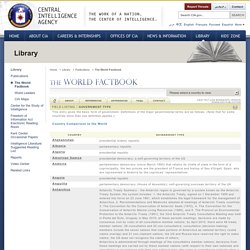
We read every letter, fax, or e-mail we receive, and we will convey your comments to CIA officials outside OPA as appropriate. However, with limited staff and resources, we simply cannot respond to all who write to us. Contact Information Submit questions or comments online By postal mail: Central Intelligence Agency Office of Public Affairs Washington, D.C. 20505 By phone:(703) 482-0623Open during normal business hours.
By fax:(571) 204-3800(please include a phone number where we may call you) Contact the Office of Inspector General Contact the Employment Verification Office Before contacting us: Please check our site map, search feature, or our site navigation on the left to locate the information you seek.